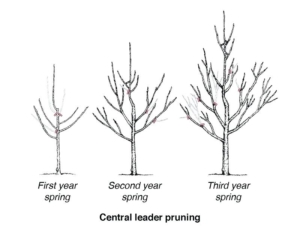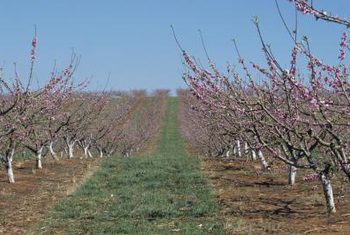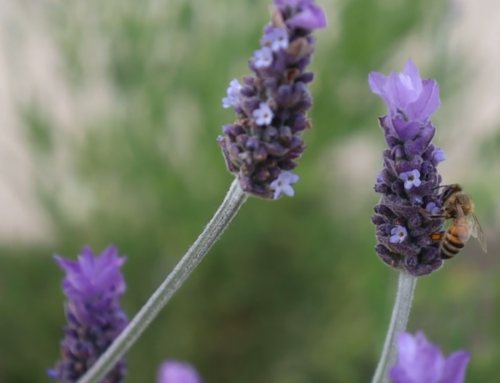Backyard Orchards – Young Fruit Trees
The early years of a tree’s life are the most important formative time in its development. When it comes to fruiting trees, that translates to the long-term health of the trees and the success of future harvests. Pruning and shaping the young trees is a science. Here are some tips for getting started on setting your new orchard up for success, with a focus on deciduous trees to be pruned in late winter.
Pruning and Shaping
The mentor of one of our designers used to lead a pruning demonstration on apple trees. Bringing a young sapling up to the front of the class, he would ask his students how best to prune the tree. When they had finished guessing, he would take his tool and make the ideal cut – straight through the trunk of the tree, leaving only a stick about 2 feet tall coming out of the pot. While of course entertaining for the shocked students, this also demonstrated the most important lesson in pruning- that weak structure can be improved by bold cuts. From this cut will develop strong, healthy new branches, which will become the structure of a successful tree. In fact, many fruit growers, upon purchasing young trees, make this cut so they will have full control over the tree’s shape.
This aged peach tree shows strong branch structure as a result of careful pruning cuts over its lifetime. Pruning scars, or the round places where old branches were removed, are normal on a healthy tree and represent the gardener’s care. We like to think they wear them proudly!
~
If your tree is quite young but more developed, with strong branching and a sturdy trunk, the cuts to be made will be for shaping. There are different opinions on how to prune fruit trees, many swear by the ‘Central Leader’ method, while others prefer the ‘Open Center’ or ‘Vase’ method for certain trees. Since visuals are always best, here are some diagrams:


Keep in mind that horizontally-oriented branches often produce the most fruit. While one wants to prioritize these, it’s also important to maintain healthy upright growth for leaf production. Pruning regularly in late winter helps protect healing trees from frost damage. Apples and pears can be pruned earliest, then stone fruits and figs.
Protecting Your Trees
If you pass a large orchard or know a gardener serious about fruit-growing, you may have seen the trunks of young trees painted white- an odd effect in mass. Whitewash or latex paint, available at many nurseries and farm supply stores, protects young trees’ trunks from sunburn in hot climates, and from borer beetle attack in trees susceptible. While not absolutely necessary, it is an easy way to avoid worrying about these problems. Paper and burlap wraps are also a common solution for young trees to protect from sunburn.
Photo from SF Gate
Throughout the year, it’s important to keep an eye on young trees to make sure they are developing well and are safe from pests and damage. Late frosts can be serious for undeveloped trees, so cover them with frost cloth on the coldest nights. Damage from deer or rodents can also be devastating for young trees, so keep an eye out for their activity and deter them if possible. Staking trees is also a wise choice for the first years, especially in windy areas. Stakes are best placed some distance out from the trunk and secured with rubber ties to allow the tree some movement while avoiding bark damage.
With attention to your trees’ needs in the early years, you will have successful harvests for decades to come! Write a reminder on your calendar to prune your trees next February or early March. We wish you the greatest success with your new home orchard!
~








